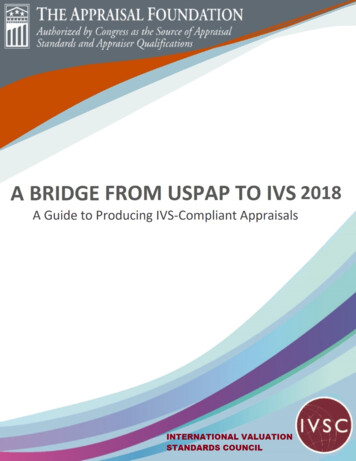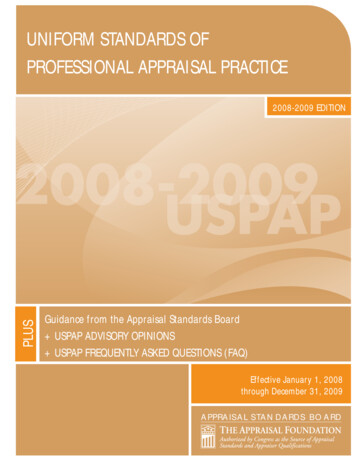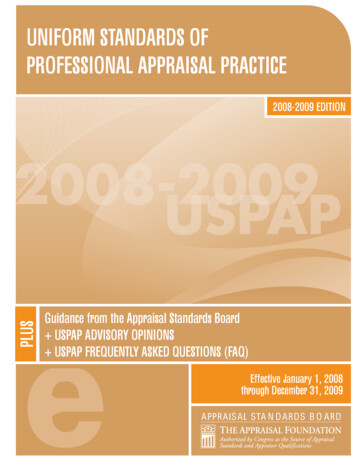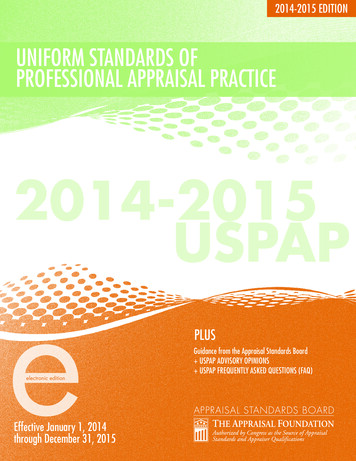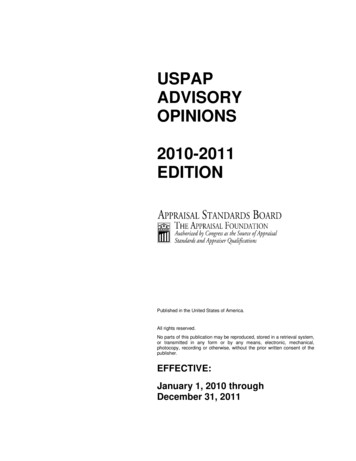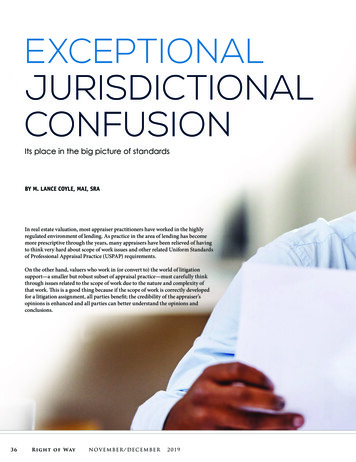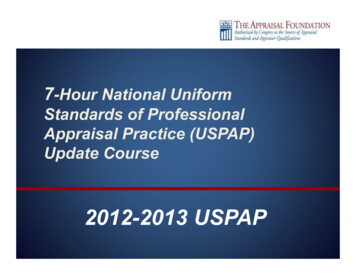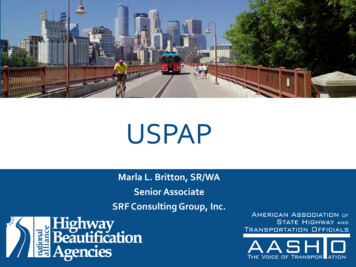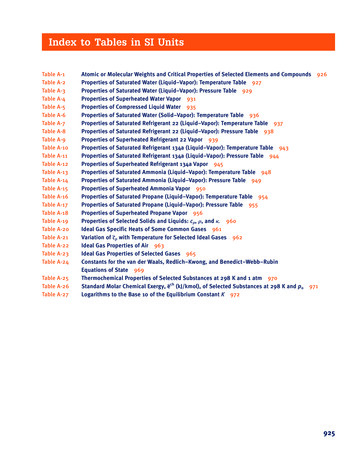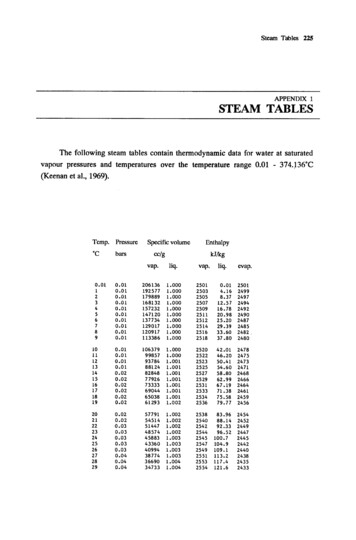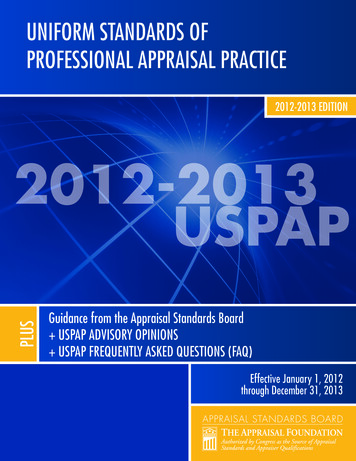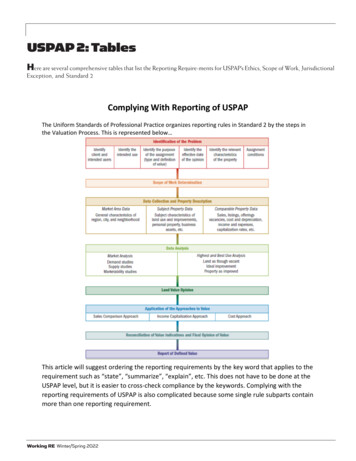
Transcription
USPAP 2: TablesHere are several comprehensive tables that list the Reporting Require-ments for USPAP’s Ethics, Scope of Work, JurisdictionalException, and Standard 2Complying With Reporting of USPAPThe Uniform Standards of Professional Practice organizes reporting rules in Standard 2 by the steps inthe Valuation Process. This is represented below This article will suggest ordering the reporting requirements by the key word that applies to therequirement such as “state”, “summarize”, “explain”, etc. This does not have to be done at theUSPAP level, but it is easier to cross-check compliance by the keywords. Complying with thereporting requirements of USPAP is also complicated because some single rule subparts containmore than one reporting requirement.Working RE Winter/Spring 2022
Six Overarching Requirements of Reporting from USPAP Standard 2There are six overarching requirements from Standard 2. One must address the following to comply withthe reporting requirements of USPAP.RequirementBe appropriate for the intended useContain sufficient information to enable the intendedusers of the appraisal to understand the report properly.Clearly & accurately set forth the appraisal in a mannerthat will not be misleading.Provide sufficient information to indicate that theappraiser complied with the requirements of STANDARD 1The report must, at a minimum, contain the requirementsof SR 2-2(a) & SR 2-3Comply with reporting and disclosure rules in other partsof USPAP.SourceSR 2-2(a) Line 589SR 2-1(b) Line 576SR 2-1(a) Line 575 for intentionalor unintentional & Conduct forintentional misleadingSR 2-2(a)(x) Line 620SR 2-2(a) Line 589Ethics Rule, Competency, Scopeof Work Rule & JurisdictionalException. In addition, theappraisal report mustprominently state the reportingoption per SR 2-2 line 582.There are problems with the manner the appraiser would use the USPAP document to judge compliancewith all the reporting rules.1. The requirements are not in one place so that it would not be easy to measure if a reportcomplies with all rules.2. The order requirements in SR 2-2(a) follow the order of the Valuation Process. Therefore, thekey words such as “state” or “summarize” are mixed throughout USPAP.3. Many of the important terms are undefined such as “sufficient”, “consistent”, “appropriate”,“clearly”, and “accurately.”4. There is no guidance, and there is no objective measurement, for being appropriate for theintended use.”5. There is no guidance, and there is no objective measurement, for “containing sufficientinformation for the intended users.”1This article will not address the potential Constitutional argument that holding an appraiser to such unobjectivestandards could be too vague to be enforceable. Instead, objective application will be offered.1Winter/Spring 2022 Working RE
Be Appropriate for the Intended UseThis should be judged by the client and appraiser. It would be helpful to get a response in writing fromthe client that the content of the appraisal report was appropriate for the intended use. An objectivestandard is offered in a matrix following.2 The following is not from USPAP but is suggested as anobjective rating system.Rating12345Intended UseLending – Low LTV, high credit rating, safe real estate property.3Litigation – Not discoverable by the other side & not admitted into evidence.4Other – Low impact on the use of the appraisal with the intended use and thus minimumwriting is necessary.Lending – Low to typical LTV, high to medium credit rating, some risk real estate property,typical property.Litigation – Discoverable by the other side & not admitted into evidence.Other – Low to medium impact on the use of the appraisal and thus minimum to typicalwriting is necessary.Lending – Typical LTV, medium credit rating, medium risk real estate property.Litigation – Discoverable by the other side & possibly admitted into evidence or reviewedby many non-client, non-intended users to possibly settle.5Other – Medium impact on the use of the appraisal and thus minimum writing isnecessary.Lending – High to typical LTV, low to medium credit rating, medium to high-risk real estateproperty, special use property.Litigation – Discoverable by the other side & possibly admitted into evidence or seen bymediator or arbitrator.Other – Medium to high impact on the use of the appraisal and thus minimum writing isnecessary.Lending – High LTV, low to medium credit rating or non-recourse loan, significant risk realestate property, atypical loan.Litigation – Discoverable by the other side & many intended users.Other – High impact on the use of the appraisal.An appraiser should get with the client and agree on the rating for the intended use. If there isdisagreement, the appraiser should consider writing to the greater content amount.This should be used for illustrative and educational purposes only. It would be reasonable to use a rating from 110 or some other range and with other considerations.3This could include consideration of the property’s uniqueness, location, use, comparables, etc.4All expert reports are generally written as a legal requirement. Most every attorney would require their witnessto write a minimal report that covers standard requirements but does not contain too much information that couldbe attacked. This is not to suggest the witness is an advocate but merely to point out the content of any expertreport (not just appraisal reports) is usually known by the lawyer and is part of discovery to the other side.5Knowing others will read and critique your appraisal report does not make them intended users.2Working RE Winter/Spring 2022
Contain sufficient information to enable the intended users of the appraisal to understandthe report properly.The USPAP requirement is that the intended users have sufficient information. This does not extend toany readers that are not intended users. An appraiser should attempt to get confirmation from theclient that an appraisal report does contain sufficient information to understand the report properly.This requirement is mirrored in FIRREA6Clearly & accurately set forth the appraisal in a manner that will not be misleading.The target of any report is the intended users.7 Any other reader can be misled. Any reviewer that is notan intended user should only set forth an appraisal as misleading with proof.Provide sufficient information to indicate that the appraiser complied with the requirements ofSTANDARD 1This was embodied in a Comment in previous USPAP editions. The following is the requirement in the2020-2021 USPAP FDIC § 323.4 Minimum appraisal standards.For federally related transactions, all appraisals shall, at a minimum:(a) Conform to generally accepted appraisal standards as evidenced by the Uniform Standards of ProfessionalAppraisal Practice (USPAP) promulgated by the Appraisal Standards Board of the Appraisal Foundation, 1029Vermont Avenue NW, Washington, DC 20005, unless principles of safe and sound banking require compliance withstricter standards;(b) Be written and contain sufficient information and analysis to support the institution's decision to engage in thetransaction;(c) Be subject to appropriate review for compliance with the Uniform Standards of Professional Appraisal Practice;(d) Analyze and report appropriate deductions and discounts for proposed construction or renovation, partiallyleased buildings, non-market lease terms, and tract developments with unsold units;(e) Be based upon the definition of market value as set forth in this subpart; and(f) Be performed by State licensed or certified appraisers in accordance with requirements set forth in thissubpart.[Codified to 12 C.F.R. § 323.4] [Source: Section 323.4 amended at 57 Fed. Reg. 9050, March 16, 1992; 59 Fed. Reg.29502, June 7, 1994; 80 Fed. Reg. 32684, June 9, 2015, effective August 10, 2015; 84 Fed. Reg. 53598, October 8,2019, effective January 1, 2020]7The client is just one intended user. Other intended users are established with the assignment and disclosed inthe report.6Winter/Spring 2022 Working RE
Summarizing the appraisal methods and techniques employedThis does not say summarize the “approaches” used. An appraiser should summarize the appraisalmethods and techniques used. For example, the specific method or technique of qualitative orquantitative analysis in the sales comparison approach, the direct capitalization or yield capitalizationmethod used in the income approach or the reproduction/replacement cost, depreciation method andland valuation method used in the cost approach should be summarized.Stating the reasons for excluding any approach not developedThere is not a great difference between stating reasons and summarizing the reasons. The difference isthat the appraiser is not “summarizing the results”8, but is listing the reasons the approaches were notused. If you “state” a “reason,” the reason may be a lengthy discussion. Be careful “stating” reasons. Areviewer may be looking for more than a list.When excluding the sales comparison approach, the appraiser should focus on excluding the approachbecause there were no comparables and/or the adjustments could not be ascertained.When excluding the income approach the reasons could be that properties like the subject are notleased, no comparable rents could be found, occupancy could not be ascertained from the market,expenses were not available, and/or rates of return or multipliers could not be developed from themarket.When the cost approach is excluded, the reasons should be either cost, depreciation and/or land valuecould not be measured from the market.In other words, the appraiser should focus on the inputs to the approaches and state the reasons thatthe approach was excluded because of the inability to measure the inputs required in the approach.9There are nine major inputs into the three approaches 1. Land value, 2. Cost, 3. Depreciation, 4. Rents,5. Vacancy, 6. Expenses, 7. Capitalization rate, 8. Comparables, and 9. Adjustments. Discuss theexclusion of an approach because you could not measure those inputs. Otherwise, the exclusion couldThis is the requirement in the next USPAP subpart to this rule. Note that “summarizing results” in not the same as“summarizing.”9An appraiser should never state an approach was not included because the client did not request the approach orbecause the client specifically asked the appraiser not to include an approach to value.8Working RE Winter/Spring 2022
be based upon the value definition used and/or the interests appraised and the inability to conduct anapproach based upon the objective lack of ability to employ the approach.summarizing the results of analyzing the subject sales, agreements of sale, options, and listings inaccordance with Standards Rule 1-5Comply with reporting and disclosure rules in other parts of USPAPWinter/Spring 2022 Working RE
Reporting Requirements in Ethics, Scope of Work & Jurisdictional ExceptionSourceKey WordReporting RequirementCondition/CommentMust not communicate assignment results with the intent A signature is not required forConductIntentto mislead or defraud.this.Must not use or communicate a report or assignmentresults known by he appraiser to be misleading orConductUse, communicate fraudulent.A signature is not required forthis.Must not knowingly permit an employee or other personConductConductPermitto communicate a report or assignment results that areA signature is not required formisleading or fraudulent.this.Must not perform an assignment in a grossly negligentThis would apply toGrossly negligent manner.If known prior to agreeing to perform an assignment,development & reporting.Disclosure is required 1. to theand/or if discovered at any time during the assignment, an client & 2. in the certification.appraiser must disclose to the client, & in each subsequent Note this certificationConductDisclosereport certification: 1. any prospective interest in theomission is an ethical issue.subject property or parties involved; and any servicesNote also, this is easilyregarding the subject property.within the three-yearforgotten when doing anperiod immediately preceding the agreement to performupdate.An appraiser must disclose that he or she paid a fee orcommission, or gave at thing of value in connection withManagementManagementDiscloseContingentthe procurement of an assignment. This is in 1. theYou don’t have to disclosecertification & 2. in any transmittal letter.how much was paid.Must not agree to perform an assignment that isThis again relates to what ancontingent upon the reporting of a predetermined value.appraiser certifies to,An appraiser must affix, or authorize the use of his/hersignature to certify recognition & acceptance of his/herUSPAP responsibilities in an appraisal or appraisalreview assignment. An appraiser may authorize the use ofhis/her signature ONLY on an assignment-by-assignmentManagementAffixbasis.SOW is mainly a developmentScope of WorkDisclose an appraiser must 3. disclose the scope of work in therule. There are disclosurereportrequirements.Others such as non-intendedusers are not included in thisScope of WorkDiscloseThe report must contain sufficient information to allowrequirement. The disclosurethe client and other intended users to understand thedoes not have to be in ascope of work performed.defined section of the report.SOW relates to the "type &Scope of WorkThe information disclosed must be appropriate for theextent of research &DiscloseClearly &intended use of the assignment results.analyses " (from Definitions).Attorney instructions areconspicuously1. What is voided by law or regulation, 2. cite in the report NOT a JurisdictionalJurisdictional Exception disclosethe law or regulation requiring this exception to USPAPException.Many of the reporting requirements included above are included in the Standard 2 requirements of a report.The Ethics requirements above throw the lack of disclosure of some as ethical issues, not just USPAP non-reporting issues.For Scope of Work requirements see AO28, Scope of Work Decision, Performance, and Disclosure & AO29 An Acceptable Scope of Work .Advisory Opinions Related to Reporting.Working RE Winter/Spring 2022
Standard Rule 2-2(a) by keyword Reporting Requirements of Standard 2 for Appraisal Reports By Key WordSourceSR 2-1(a)SR 2-2(a)SR 2-1(c)SR 2-1(b)SR 2-2(a)(iv)SR 2-2(a)(x)Key WordReporting RequirementCondition/CommentClearly & accurately set forth the appraisal in a mannerthat will not be misleadingSee the definition of"misleading." It can beintentional or unintentionalThe content must be appropriate for the intended useand at a minimum include the following The following checklistcontains some conditionalrequirements. Therefore,not applicable always.Clearly/accuratelydisclose10Clearly & accurately disclose all assumptions,extraordinary assumptions, hypothetical conditions &limiting conditions used in the assignmentSuggestion: Put all of thesein the body of the report &put the disclaimer in theheading required ofextraordinary assumptions& hypothetical conditionsSufficient InfoContain sufficient information to enable the intendedusers of the appraisal to understand the report properlyThis is measured by theintended users, notreviewers.InformationsufficientContain information, documents, and/or exhibits toidentify the real estate involved in the appraisal,including the physical, legal and economic propertycharacteristics relevant to the assignmentThis is to identify the realestate, not identifyingeverything. It also applies toonly relevant information.Provide sufficient information to indicate the appraisercomplied with the requirements of STANDARD 1 by:This is different fromprevious USPAP editions.There is a list that seems toimply if one satisfies the list,then the requirement ofshowing STD 1 complianceis met.This does not say how to dothis. It is OK to call thereport something else, butthe report must state if it isan Appraisal Report orRestricted Appraisal ReportClearly/accuratelyset forthAppropriateSufficient InfoSR 2-2Prominently stateReporting Option: 1. Appraisal Report 2. Restrictedappraisal ReportSR 2-2(a)(xiii)Clearly &conspicuouslystate11All extraordinary assumptions & hypotheticalconditionsA little humor in USPAP. We must “clearly and accurately” disclose as opposed to just disclose as required inother rules. I guess in the other “disclose” rules, they don’t have to be “clearly and accurately” disclosed.11A little more humor. We must “state” something in other rules but here we must “clearly and accurately state.”This seems to say we don’t have to “clearly and accurately state” in other areas, just “unclearly and inaccuratelystate.”10Winter/Spring 2022 Working RE
SR 2-2(a)(xiii)Clearly &conspicuouslystateState their use may have effected the assignment results.This applies toextraordinary assumptions& hypothetical conditions.SR 2-2(a)(i)StateIdentity of clientUnless the client requeststhis withheld.SR 2-2(a)(ii)StateIdentity of any other intended users by name or typeSR 2-2(a)(iii)StateIntended use of the appraisalSR 2-2(a)(v)StateThe real property interest appraised.SR 2-2(a)(vi)StateThe type of valueSR 2-2(a)(vi)StateThe definition of valueSR 2-2(a)(vi)SR 22(a)(vi)(Comment)StateCite the sourceStateReasonable exposure time in compliance with SR 1-1(c)SR 2-2(a)(vii)StateThe effective date of the appraisalSR 2-2(a)(vii)StateThe effective date of the reportSR 2-2(a)(x) (2)StateThe reasons for excluding the three approaches to valueif any not developedSR 2-2(a)(x) (4)StateThe value opinions & conclusionsSR 2-2(a)(xi)StateUse of the real estate existing as of the effective dateSR 2-2(a)(xi)StateThe use of the real estate reflected in the appraisal.SR 2-2(a)(xii)StateThe opinion of highest & best useSR 22(a)(vi)(Comment)Summarize &ExplainIf based upon non-market financing terms or unusualconditions or incentives, summarize the terms andexplain the influences on value.SR 2-2(a)(viii)SummarizeThe scope of work used to develop the appraisalSummarizeMight include disclosure of research & analyses notperformed.SR 2-2(a)(viii)CommentWorking RE Winter/Spring 2022Fee simple, leased fee,leasehold estate, reversion,easement, etc.The contingency is this isrequired if all were notincluded. Also, this isdifferent from past USPAPwhich required one to"explain" the exclusions.There is the use of "opinion"in four places in STD 1. (1)land value, (2) value, (3)reasonable exposure time, &(4) highest & best use. Thereis no use of "conclusions"specifically in STD 1. It isincluded with "opinions &conclusions." Furthermore,the two terms are notdefined in USPAP and oftenoverlap in usage and indictionaries.(should add of theappraisal)This appears to includeseller paid points, unless theappraiser concludes theyare "market" & not "nonmarket."This is conditional, but thereis no information on whattriggers this in a report.
SR 2-2(a)(ix)SR 2-2(a)(x) (1)SummarizeSummarizeThe extent of any significant real property appraisalassistance.This applies only toappraisers, not other expertscontributing. See thecomment to SR 2-3 for fullrequirements.The appraisal methods & techniques employedThe difference between amethod & technique is notdefined in USPAP anddictionary's use one todefine the other.This is directed at sales,listings, agreements of sales,options.SR 2-2(a)(x) (3)SummarizeThe results of analyzing in accordance with SR 1-5SR 2-2(a)(x) (5)SummarizeThe information analyzed SR 2-2(a)(x) (5)SR 2-2(a)(x) (5) &SR 1-1(b)CommentSR 2-2(a)(x) (5) &SR 1-2(f)(iii)SR 2-2(a)(x) (5) &SR 1-2(g)(i)SummarizeSR 1-3(a) identify & analyze the effect on use & value of:(i) existing land use regulations, (ii) reasonably probablemodifications of such land use regulations, (iii)economic supply & demand, (iv) the physicaladaptability of the real estate, and (v) market area trendsSummarizeDiligence is required to identify & analyze the factors,conditions, data, and other information that would havea significant effect on the credibility of the assignmentresults.From a word search of"anal" in STD 1. Thefollowing are all analysis,analyses and analyzerequirements ofSTANDARD 1. SR 22(a)(x)(5) create asubstantial reportingchecklist.This requirement is inStandard 1 and arguablybrings into play any infoone concludes has asignificant effect on thecredibility SummarizeThis states that the appraiser must use the extraordinaryassumption to result in a credible analysisThe standard rule forreporting brings thisanalysis in the report.SummarizeIf the hypothetical condition is used for reasonableanalysisThen the appraisal reportwould have to summarizethe analysisThis analysis must besummarized in theappraisal report to complywith USPAP.SR 2-2(a)(x) (5) &SR 1-2(g)(ii)SummarizeRegardless of why the hypothetical was used it has toresult in credible analysis.SR 2-2(a)(x) (5) &SR 1-3(a)(i)SummarizeAnalyze the effect on use and value of Existing landuse regulationsSR 2-2(a)(x) (5) &SR 1-3(a)(ii)SummarizeAnalyze the effect on use and value of Reasonablyprobable modifications of such land useSR 2-2(a)(x) (5) &SR 1-3(a)(iii)SummarizeAnalyze the effect on use and value of Economicsupply & demandSR 2-2(a)(x) (5) &SR 1-3(a)(iv)SummarizeAnalyze the effect on use and value of The physicaladaptability of the real estateSummarizeAnalyze the effect on use and value of Market areatrendsSummarizing thisrequirement could belengthySummarizeAn appraiser must analyze the relevant legal factors tothe extent necessary to support the appraiser's highest &best use of the real estate.This is broken into 3 partsbut is linked together in onesentence.SR 2-2(a)(x) (5) &SR 1-3(a)(v)SR 2-2(a)(x) (5) &SR 1-3(b) CommentThis could be broken into 2parts.Winter/Spring 2022 Working RE
SummarizeAn appraiser must analyze the relevant physical factorsto the extent necessary to support the appraiser's highest& best use of the real estate.SR 2-2(a)(x) (5) &SR 1-3(b) CommentSummarizeAn appraiser must analyze the relevant economicfactors to the extent necessary to support the appraiser'shighest & best use of the real estate.SR 2-2(a)(x) (5) &SR 1-4SummarizeAn appraiser must collect, verify, and analyze allinformation necessary for credible results.SR 2-2(a)(x) (5) &SR 1-4(a)SummarizeAnalyze comparable salesSummarize the analyses ofinformation.Applies if a SalesComparison Approach innecessary SR 2-2(a)(x) (5) &SR 1-4(b)(ii)SummarizeAnalyze cost data Applies if a Cost Approachin necessary SR 2-2(a)(x) (5) &SR 1-4(b)(iii)SummarizeAnalyze comparable data to estimate (depreciation)Applies if a Cost Approachin necessary SR 2-2(a)(x) (5) &SR 1-4(c)(i)SummarizeAnalyze comparable rental data Applies if a IncomeApproach in necessary SR 2-2(a)(x) (5) &SR 1-4(c)(ii)SummarizeAnalyze comparable operating expense data Applies if a IncomeApproach in necessary SR 2-2(a)(x) (5) &SR 1-4(c)(iii)SummarizeAnalyze comparable capitalization rate data Applies if a IncomeApproach in necessary SR 2-2(a)(x) (5) &SR 1-4(d)SummarizeIf leased fee or leasehold estate analyze terms &conditions of the lease.Doesn’t apply to fee simple.Is conditional for leased fees& leasehold estates.SR 2-2(a)(x) (5) &SR 1-4(e)SummarizeAnalyze 1. the assemblage & 2. the effect on value of anassemblageConditional on having anassemblageSummarizeAnalyze 1. the anticipated public or privateimprovements & 2. the effect on value of any public orprivate improvements.Conditional on having suchimprovements.SR 2-2(a)(x) (5) &SR 1-3(b) CommentSR 2-2(a)(x) (5) &SR 1-4(f)I can answer this - no effect.This is poorly worded.What it means to say is thecontribution to an overallvalue from non-realtyproperty.Looking at SR 1-6, oneshould analyze the qualityand quantity of dataavailable within theapproaches.SR 2-2(a)(x) (5) &SR 1-4(g)SummarizeAppraiser must analyze the effect on value of such nonreal property assets.SR 2-2(a)(x) (5)SummarizeReconciliation of the dataSR 2-2(a)(x) (5)SummarizeReconciliation of the approachesSR 2-2(a)(xii)SummarizeThe support & rationale for that opinionSR 2-2(a)(xiv)IncludeA signed certification in accordance with SR 2-3SR 2-3(a)Includethe statements of fact are true & correctCertificationSR 2-3(a)Include limited only by reported assumptions and limitingconditions and are my personal, impartial, and unbiasedprofessional analyses, opinions, and conclusions.Certification (This needs tobe changed to add EA &HC)SR 2-3(a)IncludePresent or prospective interest in the propertySR 2-3(a)IncludeThree-year historySR 2-3(a)IncludeNo bias to property or partiesWorking RE Winter/Spring 2022See requirement above forSR 1-1(a)(x)(5) also.
SR 2-3(a)IncludeCompensation not contingent upon valueSR 2-3(a)IncludeCompensation not contingent upon subsequent event,value that favors cause of client, occurrence of asubsequent event, etc.SR 2-3(a)IncludeDone per USPAPSR 2-3(a)IncludeDid/did not inspectSR 2-3(a)IncludeProfessional assistanceSR 2-3(a)IncludeIf sign one part of report, must sign the certificationSupplementThe report content and level from USPAP areminimums. An appraiser must supplement a form whennecessary to ensure that the intended users of the reportare not misled & that the report complies with theapplicable content requirements.SR 2-2This may mean adding a"USPAP complianceaddendum"Suggestion to the Appraisal Foundation Standards BoardThis is a clearer ordering of Standard 2 requirements than contained in Standard 2. The ordering is bykeyword and moves away from ordering the rules by the valuation process. As previously stated, theordering of Standard 1 by the valuation process makes sense. However, keeping the order in thereporting standards is not helpful. The following is by phrases and would need to include more languagethat is currently contained in USPAP.Standard 2-2The report content and level of information requirements in this Standards Rule areminimums for each type of report. An appraiser must supplement a report form, whennecessary, to ensure that any intended user of the appraisal is not misled and that the reportcomplies with the applicable content requirements.(a) The content of an Appraisal Report must be appropriate for the intended use of theappraisal and, at a minimum:(i)Statea. That the report is an “appraisal report” (Prominently state)b. Identity of the client, or state the client’s identity is withheld and in the workfile.c. Identity of any other intended users by name or typed. Intended use of the appraisale. Real property interest appraisedf. Definition of valuei. Cite the source of the definition of valueii. Whether the opinion of value is in terms of cash or financing terms equivalent tocashiii. Or, based on non-market financingiv. Reasonable exposure time if developedg. Effective date of valueh. Effective date of the reporti. reasons for excluding the income, cost or sales comparison approachWinter/Spring 2022 Working RE
j.k.l.m.n.o.p.q.(ii)(iii)(iv)the value opinionsthe conclusionsthe use of the real estate existing as of the effective dateThe use of the real estate reflected in the appraisalThe opinion of highest and best use, if an opinion was developed by the appraiserState all extraordinary assumptions (clearly & conspicuously)State all hypothetical conditions (clearly & conspicuously)State that the use of an extraordinary assumption or hypothetical condition may haveaffected the assignment results (if used)Summarizea. Scope of work used to develop the appraisal (See also “sufficient”)b. The extent of professional appraisal assistance12c. The appraisal methods and techniques employedd. If an opinion of value is based on non-market financing terms or financing with unusualconditions or incentives, summarize the terms of the financing and explain any influenceson value.e. The results of analyzing the subject sales, agreements of sales, options, and listingsi. If such information is unobtainable, a statement on the efforts undertaken by theappraiser to obtain the information is required.ii. If such information is irrelevant, a statement acknowledging the existence of theinformation and citing its lack of relevance is required.f. Information analyzedg. The reasons that support the analysesh. The reasons that support opinionsi. The reasons that support conclusionsj. Reconciliation of the datak. Reconciliation of the approachesl. Support and rationale for the highest and best use.Describea. In Competency Rule, if you don’t have the necessary competency you must describe in thereport the lack of knowledge and/or experience and the steps taken to complete theassignment competently.Sufficienta. Information, documents, and/or exhibits to identify the real estate involved in theappraisal,b. including the physical, legal, and economic property characteristics relevant to theassignment13Do not used a canned statement to summarize the extent of the significant professional assistance. Onlyassistance from appraisers is required to be summarized in this rule. Also, do not forget to state the person(s) inthe certification who provided the significant professional assistance.13These are two requirements in SR 2-2(a)(iv). One is to identify the real estate. That can be done in many listedways. However, including sufficient information on the physical, legal, and economic property characteristics thatare relevant to the assignment could arguably take hundreds of pages.12Working RE Winter/Spring 2022
(v)(vi)c. information to enable the intended users of the appraisal to understand the reportproperly (SR 2-1(b))d. The report must contain sufficient information to allow the client and any other intendedusers to understand the scope of work performed. The information must be appropriatefor the intended use of the assignment results.Clearly and accurately set fortha. The appraisal (and communicate the appraisal) in a manner that is not misleading (SR 21(a))b. Disclose all assumptions, extraordinary assumptions, hypothetical conditions, and limitingconditions used in the assignment. (SR 2-1(c))c.
USPAP level, but it is easier to cross-check compliance by the keywords. Complying with the reporting requirements of USPAP is also complicated because some single rule subparts contain more than one reporting requirement. H ere are several comprehensive tables that list the Reporting Require-men
